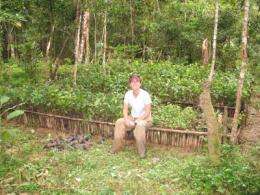Can nature parks save biodiversity?

The 14 years of wildlife studies in and around Madagascar's Ranomafana National Park by Sarah Karpanty, associate professor of wildlife conservation at Virginia Tech's College of Natural Resources and Environment, and her students are summarily part of a paper on biodiversity published July 25 by Nature's Advanced Online Publication and coming out soon in print.
As human activities put increasing pressures on natural systems and wildlife to survive, 200 scientists around the world carved up pieces of the puzzle to present a clearer picture of reality and find ways to mitigate the destructive forces at work.
Titled "Averting biodiversity collapse in tropical forest protected areas," the paper was coordinated by William F. Laurance of the Smithsonian Tropical Research Institute and James Cook University's Centre for Tropical Environmental and Sustainability Science and School of Marine and Tropical Biology. Nature is the prestigious international weekly journal of science that focuses on the natural environment.
The study, which looked at more than 30 different categories of species, from butterflies to large predators, within protected areas across the tropical regions of the Americas, Africa, and Asia, concludes that many of the world's tropical protected areas are struggling to sustain their biodiversity.
"But some of the arks are in danger of sinking, even though they are our best hope to sustain tropical forests and their amazing biodiversity in perpetuity," Laurance said.
The scientists estimated how these species groups had changed in numbers over the past two to three decades, while identifying environmental changes that might threaten the reserves, such as the deforestation advancing rapidly in tropical nations. Calling the tropical forests the biologically richest real estate on the planet, the team found many nature reserves acted like mirrors — partially reflecting the threats and changes in their surrounding landscapes.
Karpanty's role was to provide an expert review of her research in Madagascar since 1998, with attention on the state of the wildlife she studied, the threats to both the wildlife and the park, and how changes outside the park boundary impact wildlife inside the park.
In particular, the College of Natural Resources and Environment researcher contributed data on raptor, carnivore, and lemur populations in Ranomafana National Park. Assisting her in the research were master's students Brian Gerber and Mary Kotschwar, both of whom received their degrees in fisheries and wildlife sciences from Virginia Tech in 2010.
"This is a uniquely comprehensive, up-to-date, and honest assessment about the role of protected areas in saving biodiversity in the tropics," Karpanty said of the entire Nature paper. "The large project was a collaborative effort by scientists from around the world to contribute their data and insight to the question of whether nature and wildlife parks can save the world's biodiversity."
The answer? While most reserves were helping to protect their forests, about half were struggling to sustain their original biodiversity, including old-growth trees, big predators and other large-bodied animals, many primates, stream-dwelling fish and amphibians, and other wildlife. The researchers found that reserves that were suffering most were those that were poorly protected and suffered encroachment from illegal colonists, hunters, and loggers.
"The take-home point," Karpanty emphasized, "should not be viewed in a negative light, in terms of thinking that hope is lost for biodiversity in the tropics. We need to be as aggressive in eliminating threats outside of park boundaries as we are in establishing new parks or maintaining existing ones. In many ways, the findings are common sense. However, sometimes 'we,' meaning society, need a wake-up call about the obvious."
Journal information: Nature
Provided by Virginia Tech















